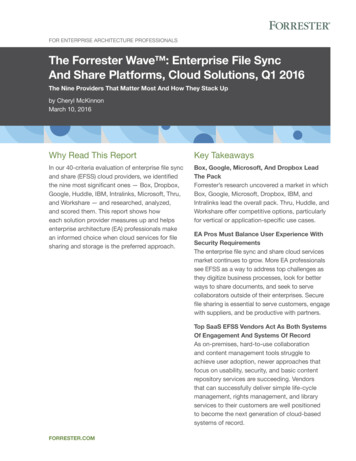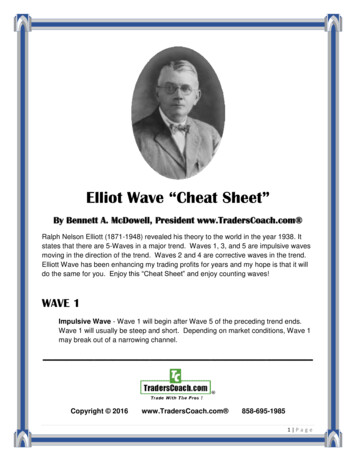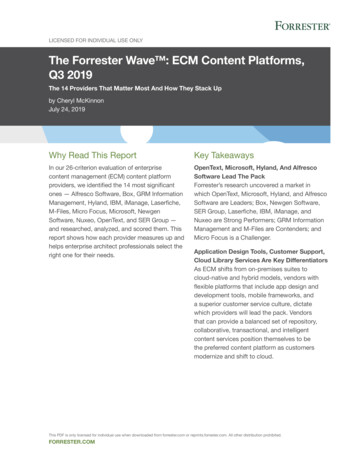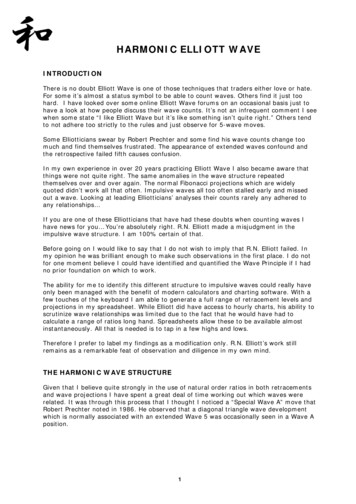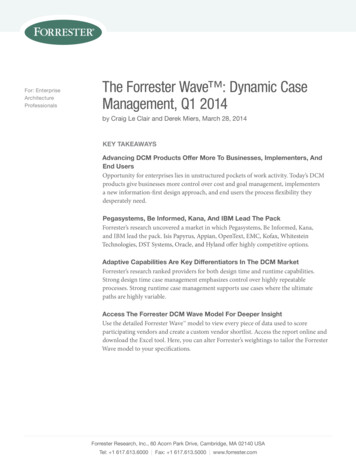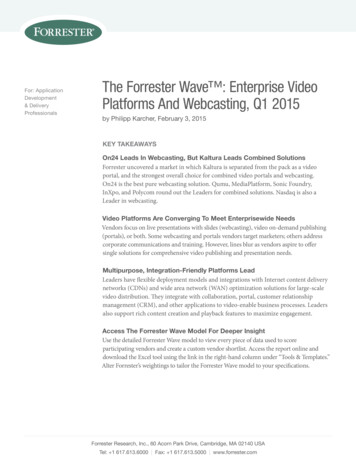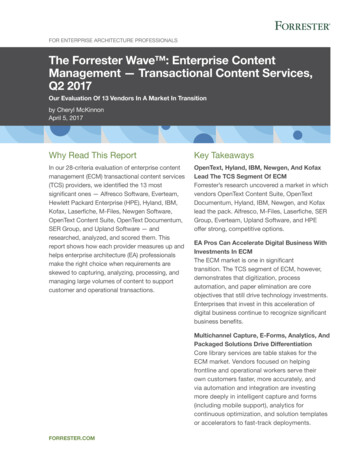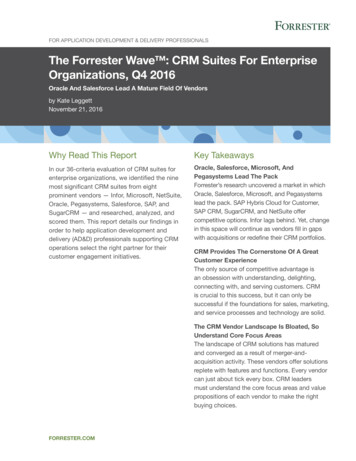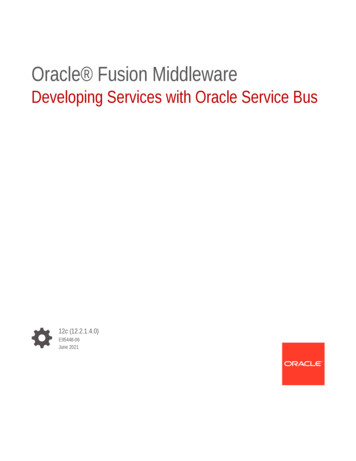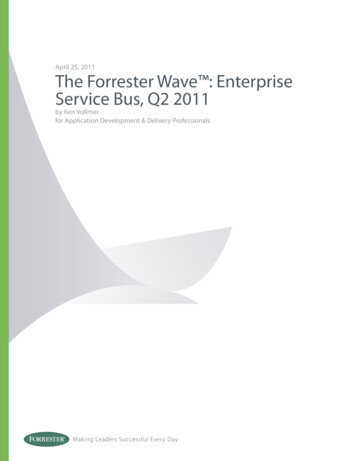
Transcription
April 25, 2011The Forrester Wave : EnterpriseService Bus, Q2 2011by Ken Vollmerfor Application Development & Delivery ProfessionalsMaking Leaders Successful Every Day
For Application Development & Delivery ProfessionalsApril 25, 2011The Forrester Wave : Enterprise Service Bus,Q2 2011Software AG, Tibco Software, Oracle, And Progress Software Lead The Wayby Ken Vollmerwith Mike Gilpin and Sander RoseExecut i ve S u m ma ryIn Forrester’s 109-criteria evaluation of both commercial and open source enterprise service bus (ESB)vendors, we found that Software AG, Tibco Software (Tibco), Oracle, and Progress Software are Leadersbecause of their broad functionality across the architecture, orchestration, mediation, connection,and change and control areas of this evaluation. Two open source ESBs from FuseSource and WSO2also made the Leader category, as did two separate ESB products from IBM. In addition, two otheropen source products from MuleSoft and Red Hat scored as Strong Performers along with a third ESBproduct from IBM.tab l e o f Co nte nts2 ESBs Provide A Lot Of Integration CapabilityIn A Small PackageESBs Are In High DemandESBs Will Play An Increasingly Important RoleIn Supporting Integration And SOAThe ESB Market Landscape6 Enterprise Service Bus Evaluation OverviewBuyers Focus On Core Integration FeaturesAnd Support For SOAThe Evaluated Vendors Provide FoundationalIntegration Support8 The Forrester ESB Evaluation10 Vendor ProfilesLeaders Provide The Most-ComprehensiveSupport For ESB FeaturesStrong Performers: MuleSoft, IBM WESB, AndRed Hat12 Supplemental MaterialNOT E S & R E S OURC E SDuring December 2010 and January2011, Forrester conducted briefings anddemonstration reviews with five commercialand four open source ESB product vendors:FuseSource, IBM, MuleSoft, Oracle, ProgressSoftware, Red Hat, Software AG, Tibco Software,and WSO2. We also conducted interviewswith more than twenty customers who arecurrently using the evaluated products. Duringthe past 24 months, we have also spoken withhundreds of customers related to their ESBimplementation activities.Related Research Documents“The Evolution Of Integration Alternatives”February 4, 2011“The Forrester Wave : ComprehensiveIntegration Solutions, Q4 2010”November 9, 2010“The ESB Reference Architecture Model”March 26, 2010 2011 Forrester Research, Inc. All rights reserved. Forrester, Forrester Wave, RoleView, Technographics, TechRankings, and Total EconomicImpact are trademarks of Forrester Research, Inc. All other trademarks are the property of their respective owners. Reproduction or sharing of thiscontent in any form without prior written permission is strictly prohibited. To purchase reprints of this document, please email clientsupport@forrester.com. For additional reproduction and usage information, see Forrester’s Citation Policy located at www.forrester.com. Information isbased on best available resources. Opinions reflect judgment at the time and are subject to change.
2The Forrester Wave : Enterprise Service Bus, Q2 2011For Application Development & Delivery ProfessionalsESBS Provide A lot of integration capability in a small packageAt their core, ESBs are integration tools. They provide broad capabilities in several key functionalareas such as connectivity, message transformation and routing, transaction mediation, basic processorchestration, and security that are critical to supporting effective integration capability. ESBs are alsovery well suited for supporting the implementation of a service-oriented architecture (SOA) due totheir ability to support the creation and use of a wide range of technical and business services.ESBs have evolved quickly over the past several years and currently provide a wide range offunctionality that was previously restricted to only high-end integration tools.1 However, the highend integration tool providers have not been standing still either, so there is still a significant gapbetween the functionality an ESB provides and the functionality a comprehensive integrationsolution provides (see Figure 1).2ESBs provide functionality that is bundled into five functional areas as follows:· Architecture. The main issues covered in this area are support for fault tolerance, scalabilityand throughput, the ability to federate with other ESBs, the supported topologies, and featuressupporting extensibility.· Connection. The key features in this group include support for a wide range of messagingstandards, communications protocols, and connectivity alternatives.· Mediation. This group deals with key requirements related to dynamic provisioning ofresources, transformation and mapping support, transaction management, policy metamodelfeatures, registry support, and service-level agreement coordination.· Orchestration. This layer provides lightweight orchestration of services and more-robustbusiness process execution language (BPEL) and/or business process modeling notation(BPMN) support.· Change and control. The main components in this group are design tooling, life-cyclemanagement, technical monitoring, and security.The ESB Forrester Wave evaluation spreadsheet explores all of these functional areas in depth aswell as scores evaluated vendors’ capabilities within each.April 25, 2011 2011, Forrester Research, Inc. Reproduction Prohibited
The Forrester Wave : Enterprise Service Bus, Q2 2011For Application Development & Delivery ProfessionalsFigure 1 The ESB Reference Architecture ModelChange and controlOrchestrationBPEL supportLightweight orchestrationDesign toolingMediationLife-cyclemanagementDynamic provisioningPolicy metamodelRegistryTransformation and mappingTransaction managementSLA 8074FederationTopologyExtensibilitySource: Forrester Research, Inc.ESBs Are In High DemandRespondents to Forrester’s Q1 2011 Global Application/B2B Integration Online Survey, whorepresent a sampling of client enterprises, indicated a high level of interest in ESBs (see Figure 2).The survey included 167 application development and enterprise architecture personnel located inthe North American, Europe, and Asia Pacific regions. The results show that 13% of the respectiveorganizations were piloting an ESB, another 13% had already implemented an ESB (but were notexpanding further), and an additional 32% were expanding their usage of an ESB. All together, 58%of the respondents were using an ESB, and another 32% were considering an ESB. Only 7% of therespondents indicated that they were not interested in this technology.Forrester has also experienced a 20% year-over-year increase in the volume of client inquiriesregarding ESBs. The most common questions we receive are: 1) “How do the leading commercialESB products compare?”; 2) “What are the leading open source ESB products?”; and 3) “Whatshould we consider before deciding to go with an open source ESB?”The broad capabilities ESB products provide have made them a popular choice for meeting generalintegration needs and supporting efforts to implement a service-oriented architecture (see Figure 3). 2011, Forrester Research, Inc. Reproduction ProhibitedApril 25, 20113
4The Forrester Wave : Enterprise Service Bus, Q2 2011For Application Development & Delivery ProfessionalsFigure 2 Survey Respondents Reported High Interest Levels In ESB“What is your enterprise’s interest level in ESBs?”Not interested7%32%ConsideringPiloting13%Implemented but not expanding13%Expanding/upgradingDon’t know32%3%Base: 167 application development managers and enterprise architectsSource: Q1 2011 Global Application/B2B Integration Online SurveySource: Forrester Research, Inc.58074Figure 3 Popular ESB Use Cases Include General Integration Needs And SOA Implementations“What functions are you using an ESB for?”95%Routing92%Messaging77%Data transformation58%Transaction mediation35%Creation of services28%BPEL-based orchestrationBPEL-based development14%Base: 74 application development managers and enterprise architects who are using an ESB(multiple responses accepted)Source: Q1 2011 Global Application/B2B Integration Online Survey58074April 25, 2011Source: Forrester Research, Inc. 2011, Forrester Research, Inc. Reproduction Prohibited
The Forrester Wave : Enterprise Service Bus, Q2 2011For Application Development & Delivery ProfessionalsThe vast majority of respondents using an ESB are using it for messaging (92%) and routing(95%). In addition, a high percentage of ESB users are also using them for data transformation(77%). ESB use cases for data transformation are distinct from those typically ascribed to extract,transform, and load (ETL) middleware. ESBs are making rapid, inline transformations feasiblewhen maintaining a near-real-time service level for information delivery; the ESB approach totransformations makes them inherently less complex and comprehensive than the transformationspossible when taking a more batch-oriented ETL approach.The balance of the use cases includes transaction mediation (58%), creation of services (35%), BPELbased orchestration (28%), and BPEL-based development (14%). Creation of services and BPELusage scenarios are frequently examples of composition — whereby the ESB delivers a larger-grained,aggregate service interface, which is composed through the ESB from multiple finer-grained services.ESBs Will Play An Increasingly Important Role In Supporting Integration And SOAThe increasing capability of both commercial and open source ESBs and their lower price pointscompared with comprehensive integration solutions (CISes) will continue to drive high interest inthese products from organizations that are modernizing their application development infrastructure.ESBs provide a lightweight option for increasing integration capability that enables firms to:· Begin with a lower-cost integration solution. ESBs provide strong support for SOA and manyother enterprise application integration challenges, and they are a logical first step in obtainingpackaged integration technology.· Consider the potential of an open source ESB. If price is an overriding concern and yourorganization has sufficient internal technical resources, an open source solution may beappropriate. Open source ESBs scored higher in this evaluation than in the last one becauseof generally increased functionality. Open source ESB vendors made significant progress incatching up with commercial ESB providers and now provide a viable option for a growingnumber of enterprises. However, open source ESB customer references cited somewhat higherlevels of support concerns, so you must ensure that the necessary support skills are availableinternally or via a support contract with the specific open source ESB provider.· Upgrade to a more robust solution as the need arises. Whether you start with a low-costcommercial ESB or an open source ESB, upgrading is feasible, as ESB functionality is at thefoundation of all CIS alternatives, making the upgrade path less of an issue than it mightotherwise be. Bottom line, if you are using an ESB, it does not require a major effort to moveto the same vendor’s CIS. However, moving from one vendor’s ESB to another vendor’s CISwould be more complex, as it would have an impact on program code and would necessitate reauthoring most configuration and policy metadata. 2011, Forrester Research, Inc. Reproduction ProhibitedApril 25, 20115
6The Forrester Wave : Enterprise Service Bus, Q2 2011For Application Development & Delivery ProfessionalsThe ESB Market LandscapeThe ESB market consists of a number of commercial ESB products from vendors including IBM,Oracle, Progress Software, Software AG, and Tibco along with a growing list of open source optionsfrom organizations such as FuseSource, MuleSoft, Red Hat, and WSO2. This market has changedsignificantly since the 2006 time frame: Some of the leading ESB providers from that day failedto gain a sure foothold in the market (i.e., Fiorano Software Technologies and PolarLake), whileothers have been acquired and consumed into the product lines of larger vendors (for example, IonaTechnologies went to Progress Software, and Workday acquired Cape Clear).The inability of many of the earlier vendors to make it in this space does not mean that the ESBmarket is losing steam. On the contrary, today’s ESB market is more vibrant than ever, with manyorganizations planning to implement an ESB. Architects are now more cognizant of ESBs’ valueproposition than they were five years ago, and the market is growing accordingly. Indeed, theimplementation of ESB technology is a high priority for many enterprises, and other vendors can beexpected to enter this market and attempt to gain some of the market share. One example of this isthe ESB that Talend plans to announce in the near future.Enterprise Service Bus Evaluation OverviewTo assess the state of the enterprise service bus market and see how the vendors stack up againsteach other, Forrester evaluated the strengths and weaknesses of top ESB vendors.Buyers Focus On Core Integration Features And Support For SOAAfter examining past research, user need assessments, and vendor and expert interviews, wedeveloped a comprehensive set of evaluation criteria. We evaluated vendors against 109 criteria,which we grouped into three high-level buckets:· Current offering. We looked at the breadth of each vendor’s ESB offering across 79 criteria,including the major categories of architecture, orchestration, mediation, connection, and changeand control.· Strategy. We looked at the strength of each vendor’s strategy across 15 criteria, includingproduct strategy, solution cost, strategic alliances, and customer reference checks.· Market presence. To evaluate each vendor’s penetration in the ESB market, we evaluated 15criteria, including installed base, new customers, annual ESB revenue, and delivery footprint.The Evaluated Vendors Provide Foundational Integration SupportForrester included nine vendors and 11 individual ESB products in its assessment: FuseSource, IBM(three products), MuleSoft, Oracle, Progress Software, Red Hat, Software AG, Tibco, and WSO2.Each of these vendors has (see Figure 4):April 25, 2011 2011, Forrester Research, Inc. Reproduction Prohibited
The Forrester Wave : Enterprise Service Bus, Q2 2011For Application Development & Delivery Professionals· Foundational integration features. All evaluated products offer features including integratedsupport for messaging, routing, data transformation, transaction mediation, and security.· Dynamic provisioning. Each of these products has the ability to dynamically allocateadditional resources to support processing needs.· Orchestration. The evaluated vendors support creating and executing lightweight process flowsor itineraries and more-robust orchestrations based on BPEL and/or BPMN.· An ESB product that was available in the marketplace as of October 1, 2010. Each vendoralso had to provide reference customers who are actively using the product.Figure 4 Evaluated Vendors: Product Information And Selection CriteriaProduct versionevaluatedVersionrelease date4.0October 2008VendorProduct evaluatedFuseSourceFuse ESBIBMWebSphere Enterprise Service Bus (WESB)7December 2009WebSphere Enterprise Service Bus RegistryEdition (WESBRE)7October 2010WebSphere Message Broker (WMB)7October 2009MuleSoftMule ESB3September 2010OracleOracle Service BusProgress SoftwareSonic ESB8Red HatJBoss ESB5.0.2Software AGwebMethods ESB PlatformTibco SoftwareActiveMatrix Service BusWSO2WSO2 ESB11 g R18.03.0.13.0April 2010March 2010July 2010December 2009August 2010May 2010Vendor selection criteriaThe vendor provides an enterprise service bus product that supports features to provide capabilities inthe following areas: architecture (extensibility and federation), connection (messaging and routing),mediation (dynamic provisioning, transformation, and transaction management), orchestration, andsecurity.The vendor has been determined to be one of the leading commercial or open source providers of ESBtechnology.The product version has been released and was in use in the marketplace as of October 1, 2010.Source: Forrester Research, Inc. 2011, Forrester Research, Inc. Reproduction ProhibitedApril 25, 20117
8The Forrester Wave : Enterprise Service Bus, Q2 2011For Application Development & Delivery ProfessionalsThe Forrester ESB EvaluationThe evaluation uncovered a market in which many familiar faces continue to thrive (see Figure 5):· Software AG, Tibco, Oracle, Progress Software, and IBM are Leaders for ESB as well as CIS.These five vendors achieved Leader status in the 2009 ESB Forrester Wave evaluation and in the2010 CIS Forrester Wave evaluation, thus garnering the top position in the integration softwareprovider market.· FuseSource and WSO2 also scored as Leaders. FuseSource and WSO2 also scored highly inmost of the evaluated areas; each of these vendors’ products represents a solid ESB solutionthat would be a good choice for meeting many enterprise integration and service-orientedarchitecture requirements.· MuleSoft, IBM’s WESB, and Red Hat products scored as Strong Performers. Though MuleSoft,IBM’s WebSphere ESB (WESB), and Red Hat products were missing some features, they stillmade the Strong Performer category. These products lack the same level of ESB support as theLeaders, but in most cases the differences were small. Consequently, each of these products mayalso be a very good fit in many enterprises, depending on the specifics of the situation.This evaluation of the enterprise service bus market is intended to be a starting point only. Weencourage readers to view detailed product evaluations and adapt the criteria weightings to fit theirindividual needs through the Forrester Wave Excel-based vendor comparison tool.April 25, 2011 2011, Forrester Research, Inc. Reproduction Prohibited
The Forrester Wave : Enterprise Service Bus, Q2 2011For Application Development & Delivery ProfessionalsFigure 5 Forrester Wave : Enterprise Service Bus, Q2 mersLeadersProgress SoftwareFuseSourceOracleWSO2Go online to downloadIBM (WESBRE)the Forrester Wave toolIBM (WMB)for more detailed productIBM (WESB)evaluations, featureTibco SoftwareRed HatSoftware AGcomparisons, andcustomizable ce: Forrester Research, Inc. 2011, Forrester Research, Inc. Reproduction ProhibitedApril 25, 20119
The Forrester Wave : Enterprise Service Bus, Q2 2011For Application Development & Delivery ProfessionalsFuseSourceIBM (WESB)IBM (WESBRE)IBM (WMB)MuleSoftOracleProgress SoftwareRed HatSoftware AGTibco SoftwareWSO2Figure 5 Forrester Wave : Enterprise Service Bus, Q2 ’11 (Cont.)Forrester’sWeighting10CURRENT OFFERINGESB product detailsAvailability ange and .470.000.004.484.004.754.264.49STRATEGYProduct strategySolution costStrategic alliancesCustomer reference 4.454.700.005.004.002.954.500.003.001.00MARKET PRESENCEInstalled baseNew customersRevenueDelivery 254.635.005.000.003.751.030.501.000.001.75All scores are based on a scale of 0 (weak) to 5 (strong).Source: Forrester Research, Inc.vENDOR PROFILESLeaders Provide The Most-Comprehensive Support For ESB Features· Software AG delivers an easy-to-use ESB. The webMethods ESB has a long track recordof providing ease of implementation and delivering value to customers. The CentraSiteregistry/repository comes bundled with the ESB. Software AG has the largest number of ESBimplementations of any of the vendors in this evaluation, and its ESB product integrates wellwith the larger webMethods Suite, including the Software AG Architecture of IntegratedInformation Systems (ARIS) business process management (BPM) product. Interviewedcustomers were pleased with the functionality that the product provides.April 25, 2011 2011, Forrester Research, Inc. Reproduction Prohibited
The Forrester Wave : Enterprise Service Bus, Q2 2011For Application Development & Delivery Professionals· Tibco provides an enterprise-ready ESB. The Tibco ActiveMatrix Service Bus scored verywell in this evaluation, placing in the Leader category and receiving many strong scores.According to customer feedback, this product works well either in a standalone environmentor as one of the key components of Tibco’s comprehensive integration solution offering(BusinessWorks). The Tibco ActiveMatrix Service Bus is widely used; Tibco reported morethan 3,000 active implementations.· Oracle provides an industrial-strength ESB product. The Oracle Service Bus was already astrong product when it was first acquired from BEA Systems a couple of years ago, and Oraclehas continued to add functionality to this product. It is one of the more widely used ESBs, withmore than 2,600 implementations in use when counting both standalone deployments andthose that take place in the larger Oracle SOA suite.· Progress Software provides an ESB with a long heritage. Based on the early, market-leadingcapabilities of SonicMQ, the Sonic ESB first came on the scene in the mid-2000s and has garnereda strong position in this market since that time. This product received strong scores in all of theevaluated areas and has also been tightly integrated into the vendor’s CIS and BPM solutions.· FuseSource scored well in its first ESB evaluation. FuseSource was formed when ProgressSoftware spun off this open source effort into a separate organization in mid-2010. Its coreproduct is the Fuse ESB, which combines features from the Apache ServiceMix ESB, the ApacheCamel integration framework, the Apache ActiveMQ message broker, and the Apache CXF webservices framework. As is the case with each of the open source ESB vendors included in thisevaluation, FuseSource reported significantly fewer production deployments compared with thecommercial vendor ESB products’ reported deployments.· WSO2 provides a strong, open source ESB. This is also Forrester’s first evaluation of WSO2’sproduct, and the vendor scored well in most of the evaluated areas. While it does have somemarquee customers, it reported significantly fewer deployments compared with the deploymentlevels of the commercial product vendors included in this evaluation.· IBM has two ESB products that made the Leader category. Forrester’s last ESB evaluationcombined multiple IBM ESB products into a single scoring exercise, thus making it somewhatdifficult for potential buyers to discern key differences between IBM’s offerings. We havecorrected that situation with this Forrester Wave, evaluating each of IBM’s three ESB productsseparately. Two of them, the WebSphere ESB Registry Edition and the WebSphere MessageBroker, made the Leader category based on their individual scores in this evaluation. WhileIBM would not divulge specific numbers, we believe the WebSphere Message Broker to have animplementation count that would rival those of Software AG, Tibco, and Oracle. 2011, Forrester Research, Inc. Reproduction ProhibitedApril 25, 201111
12The Forrester Wave : Enterprise Service Bus, Q2 2011For Application Development & Delivery ProfessionalsStrong Performers: MuleSoft, IBM WESB, And Red Hat· MuleSoft provides a solid, open source ESB. The Mule ESB has a solid track record inorganizations that have deployed it into production. MuleSoft also has the highest number ofdownloads of any open source ESB provider, though it is difficult to measure the real impactof this activity on production deployments. This product scored well in most areas of thecurrent evaluation.· IBM provides core ESB features in the WebSphere ESB. This is the last of the three IBMESBs included in this evaluation, and it scored somewhat lower than the other two. Users canresolve most of this product’s deficiencies by adding the functionality the WebSphere registry/repository product provides, and IBM has indicated that its sales efforts focus on movingcustomers to the more-capable WebSphere ESB Registry Edition product. However, for firmsthat have already implemented a registry/repository from another vendor, the lighter-weightIBM product may actually be a better fit.· Red Hat offers a comprehensive SOA solution. Red Hat offers the JBoss ESB and also amore-robust SOA platform offering. In some cases, clients would benefit from the additionalfeatures of the SOA platform, though in other situations — for example, if they have alreadyimplemented those other capabilities in some other way — architects may prefer the smallerfootprint of the JBoss ESB. Either way, Red Hat is a strong ESB provider with many satisfiedcustomers. In March 2011, Red Hat announced version 5.1 of its SOA platform. This releaseprovides significant new features that add to the overall functionality of the product.Supplemental MATERIALOnline ResourceThe online version of Figure 5 is an Excel-based vendor comparison tool that provides detailedproduct evaluations and customizable rankings.Data Sources Used In This Forrester WaveForrester used a combination of three data sources to assess the strengths and weaknesses of eachsolution:· Vendor surveys. Forrester surveyed vendors on their capabilities as they relate to the evaluationcriteria. Once we analyzed the completed vendor surveys, we conducted vendor calls wherenecessary to gather details of vendor qualifications.· Product demos. We asked vendors to conduct demonstrations of their product’s functionality. Weused findings from these product demos to validate details of each vendor’s product capabilities.· Customer reference calls. To validate product and vendor qualifications, Forrester alsoconducted reference calls with at least two of each vendor’s current customers.April 25, 2011 2011, Forrester Research, Inc. Reproduction Prohibited
The Forrester Wave : Enterprise Service Bus, Q2 2011For Application Development & Delivery ProfessionalsThe Forrester Wave MethodologyWe conduct primary research to develop a list of vendors that meet our criteria to be evaluatedin this market. From that initial pool of vendors, we then narrow our final list. We choose thesevendors based on: 1) product fit; 2) customer success; and 3) Forrester client demand. We eliminatevendors that have limited customer references and products that don’t fit the scope of our evaluation.After examining past research, user need assessments, and vendor and expert interviews, we developthe initial evaluation criteria. To evaluate the vendors and their products against our set of criteria,we gather details of product qualifications through a combination of lab evaluations, questionnaires,demos, and/or discussions with client references. We send evaluations to the vendors for their review,and we adjust the evaluations to provide the most accurate view of vendor offerings and strategies.We set default weightings to reflect our analysis of the needs of large user companies — and/orother scenarios as outlined in the Forrester Wave document — and then score the vendors basedon a clearly defined scale. These default weightings are intended only as a starting point, and weencourage readers to adapt the weightings to fit their individual needs through the Excel-basedtool. The final scores generate the graphical depiction of the market based on current offering,strategy, and market presence. Forrester intends to update vendor evaluations regularly as productcapabilities and vendor strategies evolve.Survey MethodologyForrester fielded its Q1 2011 Global Application/B2B Integration Online Survey to 167 applicationdevelopment managers and enterprise architects. Forrester fielded the survey from January toFebruary 2011.Endnotes1Comprehensive integration solutions are the most capable integration tools in the market as measuredby the total range of their functionality. For a detailed evaluation of the CIS category, see the November 9,2010, “The Forrester Wave : Comprehensive Integration Solutions, Q4 2010” report.2For more details on the components of an ESB and the components of CIS solutions, respectively, see theMarch 26, 2010, “The ESB Reference Architecture Model” report, and see the April 19, 2010, “The CISReference Architecture Model” report. 2011, Forrester Research, Inc. Reproduction ProhibitedApril 25, 201113
Making Leaders Successful Every DayHeadquartersForrester Research, Inc.Research and Sales OfficesForrester has research centers and sales offices in more than 27 cities400 Technology Squareinternationally, including Amsterdam; Cambridge, Mass.; Dallas; Dubai;Cambridge, MA 02139 USAFoster City, Calif.; Frankfurt; London; Madrid; Sydney; Tel Aviv; and Toronto.Tel: 1 617.613.6000Fax: 1 617.613.5000Email: forrester@forrester.comFor a complete list of worldwide locationsvisit www.forrester.com/about.Nasdaq symbol: FORRwww.forrester.comFor information on hard-copy or electronic reprints, please contact Client Supportat 1 866.367.7378, 1 617.613.5730, or clientsupport@forrester.com.We offer quantity discounts and special pricing for academic and nonprofit institutions.Forrester Research, Inc. (Nasdaq: FORR)is an independent research companythat provides pragmatic and forwardthinking advice to global l
The Forrester Wave : Enterprise Service Bus, Q2 2011 For Application Development & Delivery Professionals 6 The ESB Market Landscape The ESB market consists of a number of commercial ESB products from vendors including IBM, Oracle, Progress Software, Software AG, and Tibco along with a growing list of open source options
